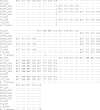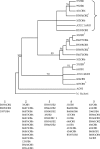Characterization of a novel gene for strain typing reveals substructuring of Aspergillus fumigatus across North America
- PMID: 17557880
- PMCID: PMC1951133
- DOI: 10.1128/EC.00164-07
Characterization of a novel gene for strain typing reveals substructuring of Aspergillus fumigatus across North America
Abstract
Fifty-five epidemiologically linked Aspergillus fumigatus isolates obtained from six nosocomial outbreaks of invasive aspergillosis were subtyped by sequencing the polymorphic region of the gene encoding a putative cell surface protein, Afu3g08990 (denoted as CSP). Comparative sequence analysis showed that genetic diversity was generated in the coding region of this gene by both tandem repeats and point mutations. Each unique sequence in an outbreak cluster was assigned an arbitrary number or CSP sequence type. The CSP typing method was able to identify "clonal" and genotypically distinct A. fumigatus isolates, and the results of this method were concordant with those of another discriminatory genotyping technique, the Afut1 restriction fragment length polymorphism typing method. The novel single-locus sequence typing (CSP typing) strategy appears to be a simple, rapid, discriminatory tool that can be readily shared across laboratories. In addition, we found that A. fumigatus isolates substructured into multiple clades; interestingly, one clade consisted of isolates predominantly representing invasive clinical isolates recovered from cardiac transplant patients from two different outbreak situations. We also found that the A. fumigatus isolate Af293, whose genome has been sequenced, possesses a CSP gene structure that is substantially different from those of the other A. fumigatus strains studied here, highlighting the need for further taxonomic study.
Figures



References
Publication types
MeSH terms
Substances
LinkOut - more resources
Full Text Sources
Medical

